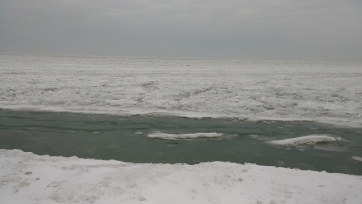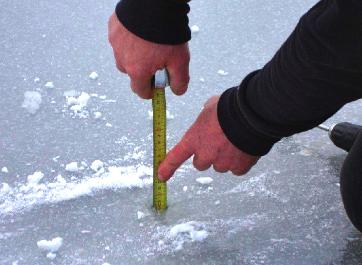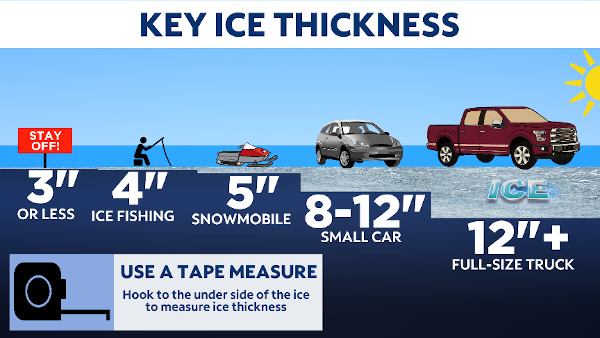Calculating Lake Ice:
Occasionally we need to get out to the island in the winter. My first two trips there were in the winter, across the ice. Not being a professional at this I must admit a bit of apprehension. But with proper research and a little common sense, I made two good trips.
NOTE: Any information on this page is for reference only. Do your own research and check with locals and or local authorities before venturing out onto frozen ice.
Factors affecting freezing
There are a lot of things that can affect ice buildup on a lake or river. Temperature (obviously) is one, but other factors such as water flow, and snow coverage can also impact ice thickness. Ice thickness is calculated using something called ‘freezing degree days’ which factors in various things like air temperature, wind speed, and radiational cooling.


Calculating Thickness
In order to calculate how much ice might accumulate on a body of water over a period of time there are several things we need to calculate:
- Average temperature of the day (High Temp + Low Temp divided by 2). And because I’m in Canada I’m going to do it in Celsius and then convert to Fahrenheit later.
- Once we have the average, then I convert that to Fahrenheit using this formula: (Temp in Celsius)*1.8+32
- To get the FDD, or Freezing Degree Day value for that day, I take the average temperature in Fahrenheit and subtract 32 from it. This doesn’t need to be a positive number.
- Then to calculate how much ice will accumulate that day (in inches), I take the FDD value and divide it by 15. And that’s about it.
There are many documents online that outline how to make this calculation. and just remember this is for clear, fresh, ice with now or little snow coverage.
To make it a little easier I created a spreadsheet that you can use. The spreadsheet keeps a running tab of 15 days. All you have to do is enter in the high and low temps (in celsius) for each day and it will do the ice calculations for you.
You can access the spreadsheet below. Note, this is a ‘use-at-your-own-risk’ document. It’s up to you to do your homework and take all safety precautions before heading out on the ice. This document is only meant to be an aid to determine how thick ice could be. There are many other factors that could contradict what this calculator suggests, leading to unsafe ice conditions like: Moving water, whether ice is supported by water or not, pressure from increased water flow, lack of support under ice due to draining water, pressure cracks, and more. Use at your own risk:
Precautions I take:
When I get to the lake….
- I carry a backpack with the following:
- cordless drill, 1.5″ spade Bit, bit extension (to drill and measure the ice thickness)
- 30′ rope, spare clothes
- knife, flash light, whistle, lighter (in waterproof baggie)
- lunch
- I only go out on skis – that spreads your weight out
- Make sure to leave a plan of your trip with someone else
Be Safe!
Do your research and have an awesome trip! The graphic below is a standard distribution image by many local first responders groups promoting winter safety tips and is meant only as a reference. Use at your own risk..

